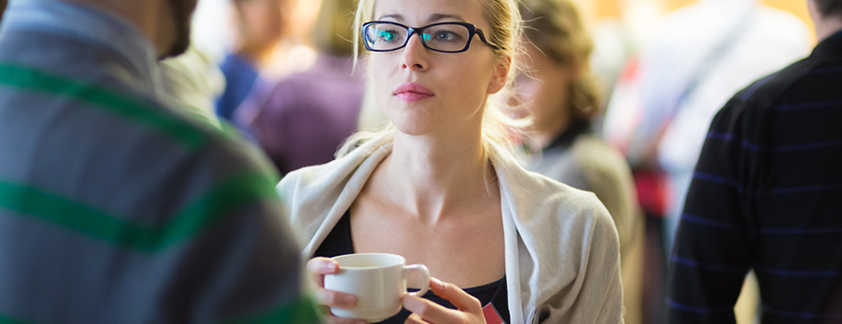There are a range of acting techniques that can easily be applied to a social or networking situation

It is part of my good fortune to have worked at sea as an Entertainment Officer on board ship. In this capacity I organised all the entertainment, from making paper flowers to singing with the band, directing the floorshows, organising the deck sports and being hostess at the Captain’s cocktail parties.
We had cocktail parties for all of the passengers and I had to ensure that they not only mingled among themselves but had an opportunity to chat to the Captain, Chief Engineer and other officers. As there were many passengers who wished to speak with the Captain sometimes I had to gently move people on, allowing them grace and ease, and I took pleasure in introducing passengers to each other and watching as people widened their networks across the ship.
I realised I was applying the tools I had explored as an actor to this social work situation.
Actors need to focus on the other performers they are working with so their reaction is truthful and they respond to what is happening at that very moment rather than offering a predetermined reaction. A side benefit of this is they take the focus off themselves, their self-consciousness is diminished and any nervousness they feel is lessened. Working in a social context is less daunting when you care more for the comfort of the other person in the exchange than for yourself.
Actors are also constantly focused on connecting to their audience. When an actor addresses the audience they break down the “fourth (unseen) wall” to create a conversation with the audience. When someone is attending a work function they too are having a conversation with an audience, it’s just it may be one or two others rather than a whole auditorium.
There are a range of acting techniques that can easily be applied to a social or networking situation:
Body language
Open and inclusive body language will encourage people to engage with you. I find that having a centred and neutral stance also helps project confidence, even when plans are going awry and inside I might be struggling to keep calm.
Improvisation
Actors’ improvisation techniques can be just as helpful in navigating a networking evening as in creating a spontaneous performance. Active listening is essential to engage in meaningful conversation � being present in the moment ensures that each individual has personal attention and endowing others with warmth means that conversation is amiable.
The improvisation techniques ‘making an offer’, in conversational terms, equates to initiating a topic and ‘accepting offers’ equates to listening and responding. On board ship, my improvisation training helped me initiate conversation making passengers feel welcome, accepting offers brought confidence to those who offered, advancing the conversation engaged other participants and blocking brought conversations to a halt.
Voice
Every actor is trained to use their voice to connect with the audience. Vocal variety including clarity of speech, changes of pitch, pace and volume are an important part of any exchange. Making sure that you are heard and understood is the responsibility of the person speaking, not the responsibility of the person who is listening.
Rehearsal
Actors rehearse using their props to make sure they do not get in the way of, but rather enhance, their performance. Networking frequently requires juggling a cup of tea or coffee, perhaps a glass or wine, using a serviette, accepting a nibble, offering a card, holding a handbag and/or shaking a hand. Practice makes perfect. A little rehearsal goes a long way to making the networker feel more comfortable.
Eye contact
Eyes are important. They speak a language of their own and they enhance communication. Eyes observe how a conversation partner is responding. Eyes watch to see if others in the room are on their own and may need to be brought into a group. Eyes look for opportunities to introduce people to each other. Observation is necessary to help an actor understand others but is also important at a work function to help understand other’s needs.
Finally, to engage an audience an actor uses a great deal of energy and it is not uncommon for an actor to finish a performance wet with perspiration. I am not saying that a social networking engagement should leave you in a damp sweat, but I am suggesting that a heightened energy level is not only natural but necessary when meeting others for the first time. Meeting new people requires reaching out, not waiting for others to come to you.
These are just some of the ways I found my acting training coming to my rescue as I navigated various social situations on board the ship. InWorking the Room at NIDA, we use these and other strategies to help make a networking opportunity less of an ordeal and a productive and enjoyable experience for everyone involved.
I always enjoyed the Captain’s cocktail parties, the Chief Engineer’s lunches, the Purser’s drinks for guests and inviting a group of passengers to my cabin for a pre-dinner drink. It gave me pleasure to see people interacting with other passengers who they may not have otherwise had the opportunity to engage with. I liked hearing the laughter and feeling the energy at a function.
Relationships began and I made new friends. Some stayed for a little while and others have stayed with me for my lifetime. Some I see often and others occasionally but we have been companions of each other’s lives. We have shared one another’s joy and, at times, sorrow. These friendships all began because my work responsibilities included communicating at a social occasion.
All views expressed are authors own.
About this author: Lyn Lee, Course Manager and Training Consultant, NIDA Corporate Read Bio Want to know more?Give her a call today on 1300 650 357 |
